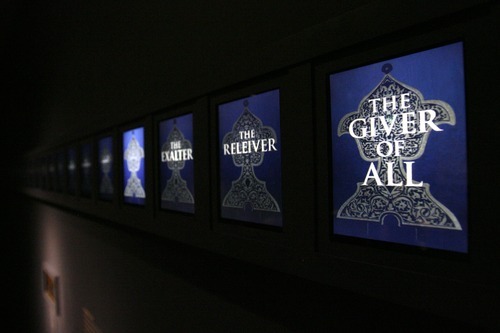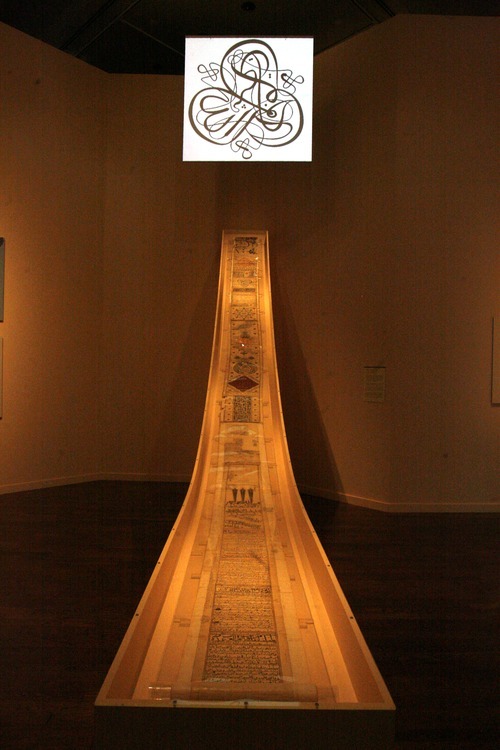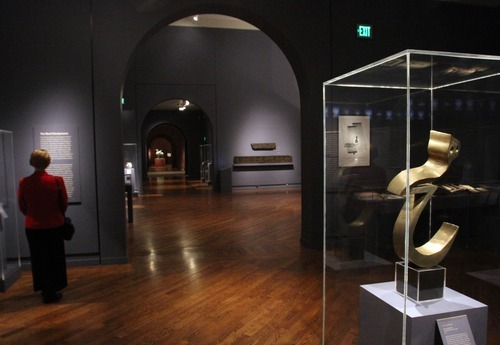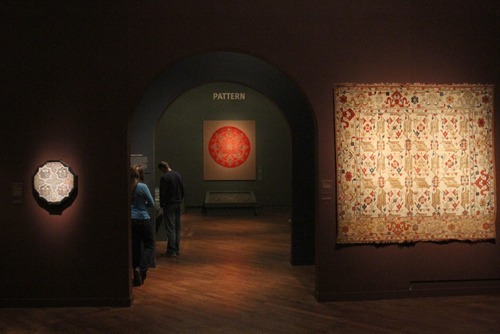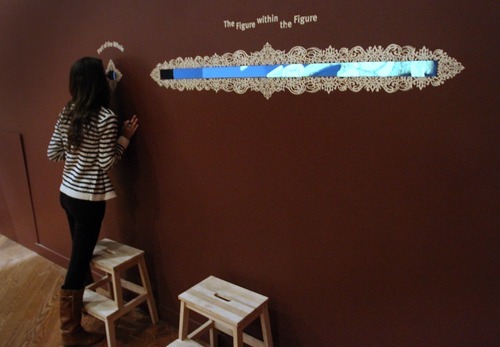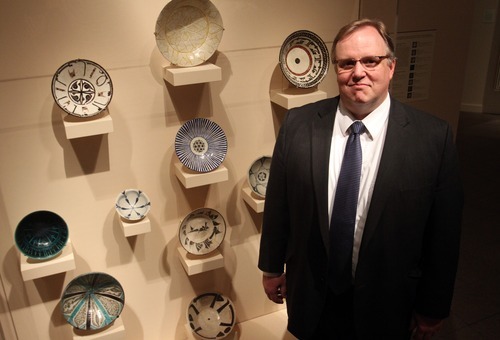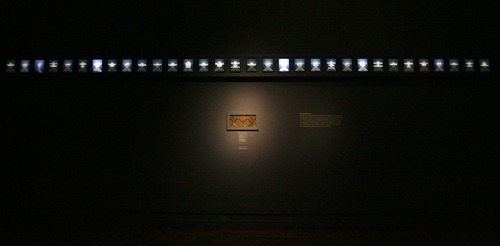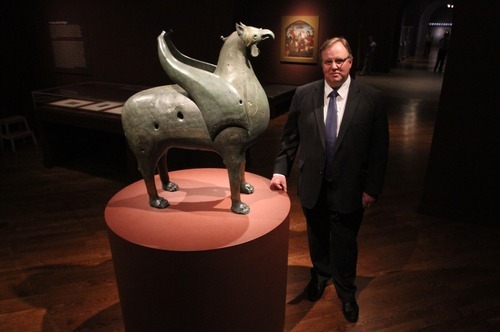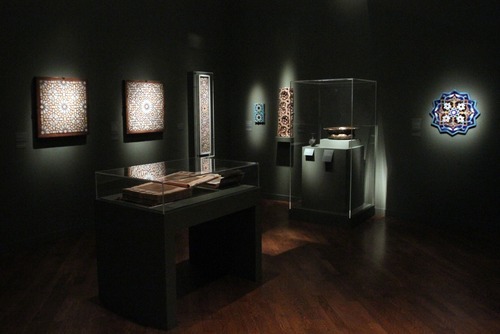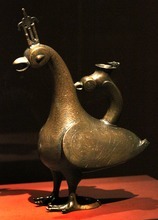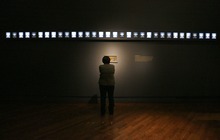This is an archived article that was published on sltrib.com in 2012, and information in the article may be outdated. It is provided only for personal research purposes and may not be reprinted.
When opening the shipping box holding a 17th-century Moroccan Quran — part of the museum's sumptuous "Beauty and Belief" exhibit of Islamic art — Brigham Young University Museum of Art officials were surprised to discover the historic artifact's condition.
It appeared that the Quran's aged binding likely would crumble if the holy book were opened for display. "It almost fell apart," says Mark Magleby, the director of the Brigham Young University Museum of Art.
"We knew how important the Quran is to Muslims, so we had to be very careful with how we proceeded," Magleby says. "So we called the institution that was lending it to find out how to proceed and asked if one of our book restoration experts could repair it, at least enough to be put on display."
The library that lent the Quran agreed to allow Mark Pollei, head conservator at BYU's Harold B. Lee Library, to stabilize the sacred text.
In light of a recent outrage in Afghanistan after several Qurans accidentally were burned at a U.S. military base there, Magleby says he was impressed by the intense respect the BYU staff showed the artifact.
"The contrast of the outrage over the burning of Qurans in Afghanistan and how differently we were respecting a Quran in a deteriorating state seemed to be very poignant," Magleby says, his voice choking with emotion. "We wanted them to see the respect the people of a disparate culture can have for Islamic culture."
—
A vision of tolerance • That kind of cross-cultural respect and understanding is exactly the goal of "Beauty and Belief: Crossing Bridges with the Arts of Islamic Culture," an exhibit at BYUMOA that extends through September. It was organized by Tunisian-born Sabiha Al Khemir, a scholar and artist who was founding director of the Museum of Islamic Art in Doha, Qatar.
"We could see her vision of creating greater understanding, in the aftermath of 9/11, of the reality of what Islam is," Magleby says of BYUMOA's commitment to the show.
Many items in the exhibit showcase eras when Muslim, Christian and Jewish scholars and artists flourished peacefully in cities in the Middle East, including Baghdad. Other works are Christian and Jewish religious artifacts produced by Muslim artists. For example, there's an 11th- or 12th-century statue of a griffin covered in Arabic calligraphy that somehow made its way from Islamic Spain into an Italian cathedral. Another significant artwork is a Torah curtain, complete with Hebrew calligraphy, from a 17th-century Egyptian Jewish temple, which was made by Muslim artisans.
"We want to re-create that kind of reciprocity between cultures here," Magleby says. "We know that is not the case in the world right now. But a Mormon university hosting this exhibit and finding the resonance, the appreciation and the awe for the art of the Islamic world — we think that reproduces that late medieval moment in Baghdad."
—
A bridge to the heart of Utah • Project director Al Khemir found that some of the donor institutions were taken aback that BYU would host the tour. "Many of the lenders asked me, 'Why Utah? Why BYU? There is no Islamic art in Utah,' " she said in a phone interview.
Al Khemir explained to them: "Because here is a religious community who actually sincerely embraced the project, who is willing to cross bridges, and in the making itself of this exhibition, many bridges have been crossed. That in itself is reinforcing to the message of this exhibition."
BYUMOA called on the university's design, computer and engineering students to work with Al Khemir to create displays to complement and explain the art. One BYU contribution is a series of video screens that displays the "99 Names of God," first showing the Arabic word, followed by the translation into English. In another section, photographs are projected on a dome-like installation to demonstrate the influence of circular patterns in nature on Islamic motifs and designs.
Altogether, this timely exhibit of the nexus of faith, calligraphy, architecture and design gives non-Muslim visitors some idea of the sacredness of the written word to Muslims and its place in Islamic art. A saying attributed to the Prophet Muhammad helps explain the outrage over the Quran burning in Afghanistan: "The ink of the scholar is holier than the blood of the martyrs."
—
Common ground 3,000 miles from Mecca • Iqbal Hossain says he's impressed with the extensive nature of the exhibit, as well as the reverence the BYUMOA has shown for his culture. Hossain is president of the Islamic Society of Greater Salt Lake, and was in regular communication with BYU officials as the exhibition was developed.
"After I walked through the exhibition, I left with a sense of pride in the heritage of Islamic traditions and art," Hossain says.
After living in Utah for three decades, Hossain doesn't find it surprising that BYU would participate in an exhibition of Islamic art, or that museum officials would supplement the artwork with explanatory installations that likely will travel to the Indianapolis Museum of Art, the Portland Art Museum and the Newark Museum in New Jersey.
The Church of Jesus Christ of Latter-day Saints and BYU always have had warm relations with the Muslim community, Hossain says. A dozen or more Mormon students visit the Salt Lake mosque every Friday to learn about Islam, and the LDS Church offers meeting rooms in the Joseph Smith Memorial Building in Salt Lake City to the Islamic community.
"There's a lot of similarities between the Islamic and the Mormon communities, in terms of family values and the fundamental dos and don'ts of life," he says.
But many Americans are unaware of the level of civilization reached by Islamic cultures during Europe's Dark Ages, or that much of Western knowledge and philosophy was preserved by Islamic scholars. "This [exhibit] dispels the myths that persist in our society about Islam and makes relations, hopefully, a little more harmonious," Hossain says.
Hossain thinks the timing of the exhibit is especially significant. "I am grateful that they would do it, particularly during a time of negative feelings toward Islam [that are] on the rise in this country."
facebook.com/nowsaltlake
Twitter: gwarchol —
Beauty and belief in Islam
The exhibition continues at the Brigham Young University Museum of Art, North Campus Drive, Provo, through Sept. 29.
Hours • Monday-Wednesday and Saturday, 10 a.m.-6 p.m.; Thursday-Friday, 10 a.m.-9 p.m.; closed Sunday.
Information • http://www.beauty-and-belief.com; 801-422-8287
Admission • Free
Also • The exhibit will travel to the Indianapolis Museum of Art, Nov. 2-Jan. 13; Newark Museum in New Jersey, Feb. 13–May 19, 2013; and the Portland Art Museum, June 15–Sept. 8, 2013.


